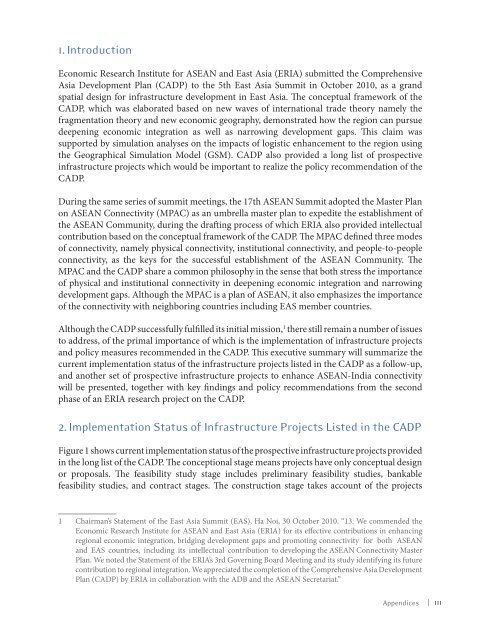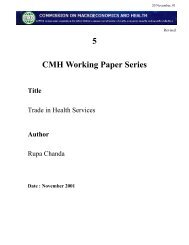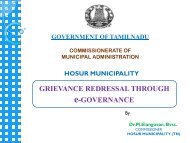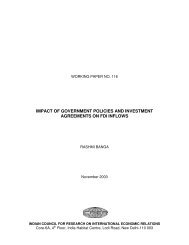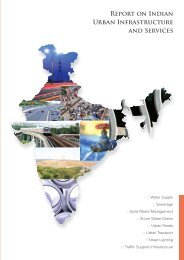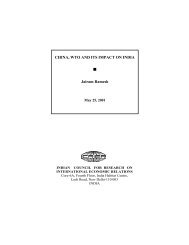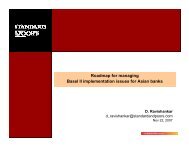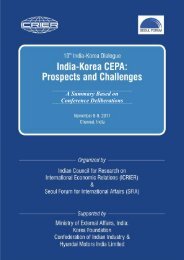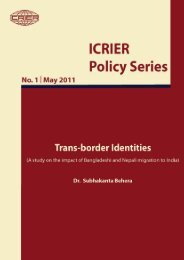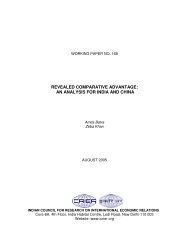Asia's Arc of Advantage - icrier
Asia's Arc of Advantage - icrier
Asia's Arc of Advantage - icrier
Create successful ePaper yourself
Turn your PDF publications into a flip-book with our unique Google optimized e-Paper software.
1. Introduction<br />
Economic Research Institute for ASEAN and East Asia (ERIA) submitted the Comprehensive<br />
Asia Development Plan (CADP) to the 5th East Asia Summit in October 2010, as a grand<br />
spatial design for infrastructure development in East Asia. The conceptual framework <strong>of</strong> the<br />
CADP, which was elaborated based on new waves <strong>of</strong> international trade theory namely the<br />
fragmentation theory and new economic geography, demonstrated how the region can pursue<br />
deepening economic integration as well as narrowing development gaps. This claim was<br />
supported by simulation analyses on the impacts <strong>of</strong> logistic enhancement to the region using<br />
the Geographical Simulation Model (GSM). CADP also provided a long list <strong>of</strong> prospective<br />
infrastructure projects which would be important to realize the policy recommendation <strong>of</strong> the<br />
CADP.<br />
During the same series <strong>of</strong> summit meetings, the 17th ASEAN Summit adopted the Master Plan<br />
on ASEAN Connectivity (MPAC) as an umbrella master plan to expedite the establishment <strong>of</strong><br />
the ASEAN Community, during the drafting process <strong>of</strong> which ERIA also provided intellectual<br />
contribution based on the conceptual framework <strong>of</strong> the CADP. The MPAC defined three modes<br />
<strong>of</strong> connectivity, namely physical connectivity, institutional connectivity, and people-to-people<br />
connectivity, as the keys for the successful establishment <strong>of</strong> the ASEAN Community. The<br />
MPAC and the CADP share a common philosophy in the sense that both stress the importance<br />
<strong>of</strong> physical and institutional connectivity in deepening economic integration and narrowing<br />
development gaps. Although the MPAC is a plan <strong>of</strong> ASEAN, it also emphasizes the importance<br />
<strong>of</strong> the connectivity with neighboring countries including EAS member countries.<br />
Although the CADP successfully fulfilled its initial mission, 1 there still remain a number <strong>of</strong> issues<br />
to address, <strong>of</strong> the primal importance <strong>of</strong> which is the implementation <strong>of</strong> infrastructure projects<br />
and policy measures recommended in the CADP. This executive summary will summarize the<br />
current implementation status <strong>of</strong> the infrastructure projects listed in the CADP as a follow-up,<br />
and another set <strong>of</strong> prospective infrastructure projects to enhance ASEAN-India connectivity<br />
will be presented, together with key findings and policy recommendations from the second<br />
phase <strong>of</strong> an ERIA research project on the CADP.<br />
2. Implementation Status <strong>of</strong> Infrastructure Projects Listed in the CADP<br />
Figure 1 shows current implementation status <strong>of</strong> the prospective infrastructure projects provided<br />
in the long list <strong>of</strong> the CADP. The conceptional stage means projects have only conceptual design<br />
or proposals. The feasibility study stage includes preliminary feasibility studies, bankable<br />
feasibility studies, and contract stages. The construction stage takes account <strong>of</strong> the projects<br />
1 Chairman’s Statement <strong>of</strong> the East Asia Summit (EAS), Ha Noi, 30 October 2010. “13. We commended the<br />
Economic Research Institute for ASEAN and East Asia (ERIA) for its effective contributions in enhancing<br />
regional economic integration, bridging development gaps and promoting connectivity for both ASEAN<br />
and EAS countries, including its intellectual contribution to developing the ASEAN Connectivity Master<br />
Plan. We noted the Statement <strong>of</strong> the ERIA’s 3rd Governing Board Meeting and its study identifying its future<br />
contribution to regional integration. We appreciated the completion <strong>of</strong> the Comprehensive Asia Development<br />
Plan (CADP) by ERIA in collaboration with the ADB and the ASEAN Secretariat.”<br />
Appendices<br />
| 111


